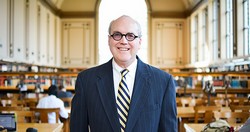The University failed to make the cut on Forbes list of “America’s Top Colleges” and their list of “Top 10 Schools of New Jersey,” released together in July.
The list ranked 660 schools, and a number of neighboring schools snagged spots on the list, with Princeton at number 3 on “America’s Top Colleges” and number 1 on “Top 10 Schools of New Jersey.” Other NJ schools that made the Forbes list include, but are not limited to, Rutgers University, Rowan University, and Drew University.
Senior marketing student Erica Villa thought the University should have made the list. She said, “The University has great academics and the success of our alumi is high. I’ve had a lot of great professors and I feel like there are a lot of resources on campus for students to help them get jobs, like Career Services.”
On the other hand, senior health student Kegan Ellis thinks that the list has a lot to do with the retention rate. “I know a lot people who transferred, which might’ve had to do with the social aspect. A lot of kids come to school looking to party, and Monmouth just isn’t the place for that,” he said.
Forbes described the methodology behind how they establish their list. In an article titled Top Colleges Ranking 2016: The Full Methedology, Forbes staff writer Caroline Howard revealed that Forbes isn’t focusing on how student’s get into college, but what they are getting out of it.
Universities are graded on five categories: post-graduate success, student debt, student satisfaction, graduation rate, and academic success. Such information is acquired through sites such as Payscale, College Scorecard, and RateMyProfessor.
For post-grad success, Forbes combines the information from Payscale, which discloses self-reported salaries, and from College Scorecard, which reveals tax records solely from former students who took out federal loans. Together, these sites provide a reading of early and mid-career salaries, and weigh 32.5 percent on the rating scale.
Additionally, Forbes takes into account who is working at the University and the accomplishments they have made. Such individuals would appear in other lists like Forbes “America’s Top Leaders” and would be winners of Nobel and Pulitzer prizes, Guggenheim fellows, and Emmy or Tony awards.
Student debt is the second highest rated category at 25 percent, and which Forbes calls “the biggest economic fail story of the past decades.” As tuition keeps rising, so do the loans.
According to an Outlook article published last year the tuition for full-time undergraduate Monmouth University students increased by 4.95 percent. The increase made the total cost for tuition and fees, excluding room and board, $35,014.
Next in the rating is student satisfaction, determined by both a school’s retention rate and student surveys. Information from the Center for College Affordability and Productivity (CCAP) indicates student transfer rate, and RateMyProfessors accounts for student evaluations.
Graduation rate holds less weight on the scale at 7.5 percent. Even though some students take five years to complete college requirements, Forbes looks strictly at a degree obtained within four years. They obtain this information from the CCAP, who creates their statistics based on graduation rate and predicted graduation rate.
Lastly, Forbes looks at academic success, accounting for 10 percent of a rating. If students are winning scholarships and fellowships, like Rhodes and Fullbright, and seeking their Ph.D, then their university’s ranking increased.
Mark Blackmon, Director of News and Public Affairs at the University said, “Forbes relies on some information that can be highly subjective…universities actually lose points for awarding grants and scholarships.”
According to Blackmon this unfairly lowers the University’s chances of getting on the Forbes list, as the school is known for awarding scholarships and grants. Last year, 97 percent of students were given financial aid, and 92 percent received a Federal, State, or University scholarship/grant.
Whereas Forbes looks negatively towards such large amounts of financial support, Blackmon disagrees. “We are actually quite proud that we can assist so many students in getting an education.”
Over $50 million given in grants and scholarships, the University ranks highly as one of the most affordable private schools in New Jersey. Although the University did not make the Forbes list, Blackmon shared the many titles that the University has received.
For the past four years, the University has been included in the U.S. News & World Report’s annual list of “Best Colleges” and was ranked in the top 40 for “Regional Universities North”. Monmouth University has also made The Princeton Review on multiple occasions, winning “Best Colleges” for 12 years running, and has been included in “The Best 381 Colleges: 2017 Edition.” The Princeton Review also lists the Leon Hess Business School in its “Best 295 Business Schools 2016” placing the University on the list for 11 consecutive years.
Moreover, the U.S. News & World Report released their annual “Best Graduate Schools” list for 2016, and recognized The Leon Hess Business School’s part-time Master of Business Administration (MBA) as one of the best programs in the nation. In 2012 and 2013 The Princeton Review included MU as one of the “Best 322 Green Colleges.”
Professors at the University have also been honored, including Gary Lewandowski, professor and Department Chair of Psychology. The Princeton Review named him one of “The Best 300 Professors” in 2013.
“Even though Monmouth failed to make the Forbes list, I think that it doesn’t reflect the quality of its teachers and the type of school that Monmouth is. I think it should have definitely made it. ”



